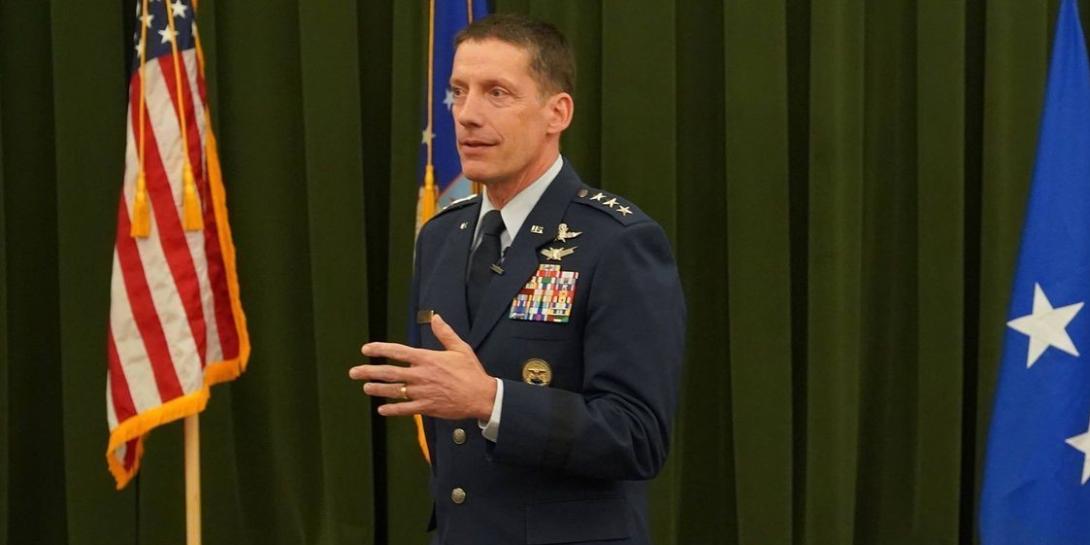DISA Prepares for Complicated Future
Amidst a complex global geopolitical environment, the Defense Information Systems Agency, or DISA, is progressing in how it provides communication and information technology as a U.S. Department of Defense combat support agency. The agency is pulling in advanced and updated technologies to support the nation’s leaders, warfighters and U.S. combatant commands against near-peer adversaries.
The agency awarded $5.9 billion dollars in contracts last year, and $1.6 billion of that went to small businesses, reported DISA Director Lt. Gen. Robert Skinner, USAF, who is also commander of the Joint Forces Headquarters-Department of Defense Information Network (JFHQ-DODIN). Gen. Skinner spoke yesterday at the AFCEA Rocky Mountain Chapter’s annual Cyberspace Symposium, held February 21-24 in Colorado Springs.
The crises in Europe, with Russia threatening to invade Ukraine, kept the director from speaking in person at the conference. In addition to that conflict, the agency has it eyes on several other adversaries.
“We are really focusing on the PRC [People’s Republic of China] right now and what China is trying to do on a day-to-day basis to really change the international rules-based order and have things be in their favor,” Gen. Skinner said. “We see all the modernization efforts that they have going on and where they want to be in the 2030, 2040, 2050 range and you see a nation that is really trying to supplant everyone else. You look at the Middle East and there is always knocking on the door when it comes to instability. Or you look at what's happening in South America from a drug-related standpoint or as a potential safe-haven for adversarial activity. You just look at the gamut of what's going on in the world and you realize that there's something always going on, and it's always chaotic. It's always dynamic.”
Gen. Skinner took the helm at DISA last February and pursued a restructuring of the agency, creating four new centers. The director has outlined technology-related priorities, and the list is daunting: command and control; modernization of legacy infrastructure, including thousands of switches and circuits; securing the future technical environment; transforming legacy applications; expanding the use of automation and orchestration; mobile device support; data-centric sensor designs; advanced hybrid cloud platforms; zero-trust architecture; and an updated risk management framework, amongst other measures.
“I will tell you in unequivocal terms that prioritizing command and control is the number one priority within the department and also within the agency,” he emphasized. “There is nothing more important than ability of our senior leaders to be able to communicate at the time and place of their choosing, securely, no matter where there are located.”
Advancing Command & Control is @usdisa and @DeptofDefense’s number one priority, says Lt. Gen. Robert Skinner, DISA Director @AFCEARMC @AFCEA pic.twitter.com/Y5CuSXv8OI
— Kimberly Underwood (@Kunderwood_SGNL) February 22, 2022
As part of its modernizing efforts, the agency is implementing an Internet isolation key solution.
“We are in the midst of deploying a cloud-based Internet isolation key capability right now, with almost 2 petabytes of data as an offload from our Internet access points,” the general mentioned. “This capability that is huge when you start talking about bandwidth and throughput. We have over 140,000 mobile devices in the department that we are providing on a day-to-day basis.”
As the commander of JFHQ-DODIN, Gen. Skinner is examining ways to possibly modernize the network as it continues to harden and protect the military’s crucial platform.
“How do we continue to secure and defend the environment that we have, the environments of SIPRNet and JWICS?” he asked, speaking of the Secret Internet Protocol Router Network and the Joint Worldwide Intelligence Communication System. “We have to continually harden and enable those capabilities, those networks and those systems. In the meantime, I want to jump to the future faster. And what is that secure environment of the future? What does it entail? Is it similar to what we have today—I hope not. Is there a future state where we can truly leverage what is out there from a commercial standpoint, and where does cryptography come into play and how can we leverage what NSA [the National Security Agency] is doing?”
Moreover, the agency is considering reducing the number of impact levels (IL) of classification, such as IL 2, 4, 5, 6. “Do we really need all those levels from a security standpoint or is there savings to be had while maintaining the proper security levels?” Gen. Skinner asked. “We’d do better to enable industry to help us as we look at what that future holds.”
In addition, DISA is conducting strategic program assessments (SPAs), looking closely at all programs to see if they are making a clear contribution. The SPA process, for instance, resulted in the advisement to cut DISA’s milCloud 2.0 program, which the agency will phase out in June. The director stressed that DISA would pursue only what is best value.
“We [pursued] the organizational design of the agency to truly ensure that we are providing best value, and that we are providing best value enabled either through contracts or through brokering and ensuring that our discussions in partnership with industry are of best value,” Gen. Skinner noted.





Comments